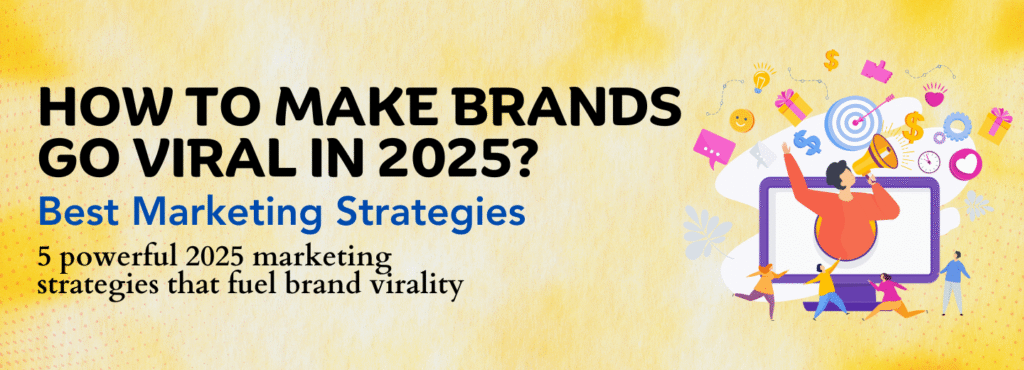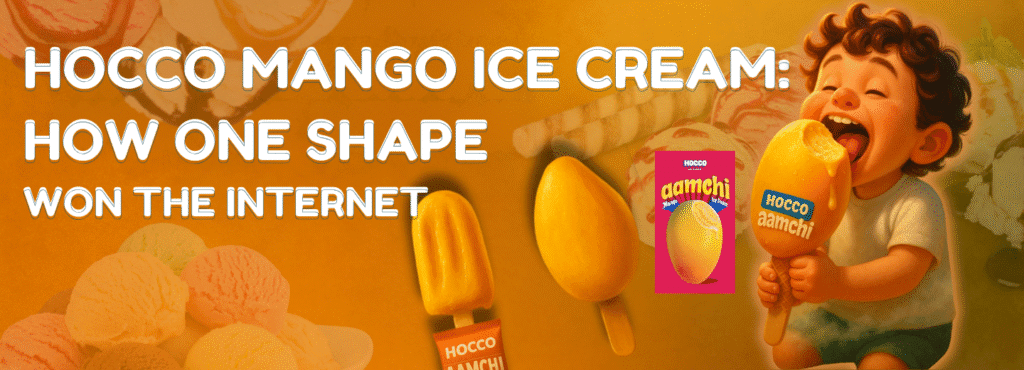How to Make Brands Go Viral in 2025: 5 Strategies Backed by Real Examples

If you’ve been wondering how to make brands go viral in 2025, you’re not alone. In today’s fast-moving world, it’s no longer enough to just have a great product — you need the right blend of storytelling, design, packaging, and strategy to break through the noise. The brands that win are the ones that embed viral marketing principles into their DNA. In this blog, we’ll uncover 5 powerful 2025 marketing strategies that fuel brand virality. Whether you’re a startup or an established brand, these insights will help you go viral in 2025 and stay top-of-mind with your audience. 1. How Design Helps Brands Go Viral 🎯 Your design isn’t just how things look — it’s how your brand feels at first glance. In 2025, scroll-stopping visuals are table stakes. Brands that go viral invest in visuals that create instant emotional responses. Take Hocco Ice Cream, for example. Their vivid product renders, neon color palettes, and playful flavors like “Kala Jamun Swirl” don’t just sell dessert — they sell a vibe. This kind of distinctive identity makes people pause, screenshot, and share. 🔁 Why it works:Good design increases brand virality by turning ordinary products into aesthetic experiences. Whether it’s your packaging, ads, or Instagram grid, consistency and creativity convert passive viewers into active fans. 🔑 2025 marketing strategies highlight: Use AI-generated design tools to rapidly test colors, compositions, and content formats for share-worthy appeal. 2. Why Packaging Makes Brands Go Viral on Social Media 📦 In 2025, packaging is media. Think beyond function — it’s storytelling in a box. Today’s viral brands use packaging as a social trigger. Look at Truff Hot Sauce. Their black-and-gold bottles, minimal labels, and high-end feel make customers want to show it off on Instagram. No surprise their viral marketing relies heavily on unboxing content. ✅ Go viral in 2025 by designing packaging that speaks to your audience’s identity. Is it gift-worthy? Does it feel premium? Is it photo-ready? This isn’t just aesthetics — it’s a viral marketing play that turns your customers into distributors of brand content. 3. Minimalism: The Secret Sauce Behind Brands Going Viral 🧠 In a sea of noise, the loudest brand isn’t the one shouting — it’s the one people remember. Think Glossier. Their minimal pink packaging, simple logo, and bare aesthetic created an iconic, recognizable identity. Their branding is so subtle that it actually stands out — a key tactic that helps brands go viral in today’s cluttered landscape. 🎯 Tip:Stick to two core colors, a repeatable logo mark, and consistent tone across platforms. Brand virality often comes from being predictable in how you show up — not random. 💡 2025 marketing strategies tip: Integrate minimalist branding into even your memes, product mockups, and influencer content. Simplicity equals stickiness. 4. Shareable Moments That Make Brands Go Viral 🗣️ Want to boost your brand virality? Make your audience the hero. The secret to viral marketing is not “please share this.” It’s: “Sharing this makes you look good.” Take Poppi Soda, for example. Their pastel cans and Gen-Z wellness vibe make people feel cool drinking (and posting) it. The product looks good on feed and feels aligned with their personal brand. 🧠 Add share triggers: 🎯 You don’t need millions of followers. You need micro-moments that invite people to post without being asked. 5. Riding Trends to Make Brands Go Viral in 2025 🌊 Sometimes, going viral isn’t about creating a wave — it’s about surfing one. Brands that go viral in 2025 know how to tap into cultural conversations. Whether it’s sustainability, nostalgia, or internet slang, you must be present where your audience already is. Case in point: Duolingo on TikTok. They hijack trends, use trending audio, and their owl mascot has become an internet celebrity. This isn’t random — it’s a smart mix of 2025 marketing strategies and real-time audience listening. ✅ Actionable step:Use tools like Google Trends or TikTok Creative Center to spot what your audience cares about right now. Then craft content around that — not what you think they want. 🚀 Want to go viral in 2025? Stop guessing. Start listening. Final Take: It’s Not Luck, It’s a System Here’s the truth: What makes a brand go viral in 2025 is a combination of psychology, timing, and strategy. You don’t need a huge budget or celebrity collab. You need: And most of all, consistency. If you apply these 5 strategies and stay close to your audience, your brand won’t just pop — it’ll stick. Remember, brands go viral because they’ve earned attention. Now it’s your turn.
Hocco Mango Ice Cream: How One Shape Won the Internet

Have You Seen the Hocco Mango Ice Cream That Looks Like a Real Mango? The now-famous Hocco Mango Ice Cream — a mango-shaped ice cream that nailed product-led marketing and ice cream marketing strategy — became a viral hit without spending a rupee on ads. It didn’t come with a big bang. There was no celebrity launch. No massive influencer campaign. Yet the Hocco Mango Ice Cream went viral, became highly shareable, and created organic buzz across platforms. As a content creator and social media marketer for F&B brands, I couldn’t help but pause and appreciate the brilliance. In fact, this is a textbook example of product-led marketing strategy done right. So let’s unpack what made this one scoop turn into a full-blown moment. The Story Behind Hocco Mango Ice Cream (and Yes, It’s Linked to Havmor) Let’s clear the air first — is Hocco the same as Havmor? Honestly, this is a common question many people still ask. Hocco is the modern, rebranded identity for Havmor’s physical stores and cafes. While Havmor continues to exist as a packaged brand found in supermarkets and retail chains, Hocco focuses on reimagining the dessert experience — with a more playful, youthful, and modern twist. Moreover, Hocco didn’t become a trending brand just because of this rebrand. It became one when it launched an ice cream that looked like a mango. The Hocco Mango Ice Cream That Spoke Without Saying a Word The Hocco Mango Ice Cream stood out from traditional desserts due to its clever shape and design. Additionally, it showcased how a mango-shaped ice cream can dominate the ice cream marketing strategy conversation without needing heavy ad budgets. Moreover, this mango-shaped ice cream offered more than flavor—it delivered a visual cue that sparked conversations and shares. There was no fancy campaign, no OTT promotions, and no “Limited Edition” gimmicks. Instead, they let the product do the talking. Just a product that visually told you what it was… and made you want to try it. Clearly, it was obvious — and that’s what made it brilliant. Why Hocco Mango Ice Cream Went Viral — With Zero Ad Spend This campaign stands as a perfect demonstration of product-led marketing — where the product design and presentation itself becomes the campaign. Here’s what made this launch such a standout in the world of food marketing: 1. The Product Was Designed for Social Media People love sharing things that are cute, clever, or nostalgic. A mango-shaped ice cream hits all three. It wasn’t just an ice cream — it was Instagram content waiting to happen. The aesthetic was bold, playful, and scroll-stopping. Therefore, half the job of a good marketing campaign was already done — without any actual campaign. 2. It Created Natural Curiosity The product alone made people ask: Every post featuring it sparked conversations, and users who reshared it actively promoted it without needing any external encouragement. 3. It Blended Nostalgia With Novelty Mangoes are already emotionally tied to Indian summers. As a result, it’s no surprise that this mango-shaped ice cream tapped into that nostalgia so powerfully. Hocco just added a novel twist by making it edible in an unexpected shape. It wasn’t a new flavor. Instead, it was a new visual twist that made people look twice. Rather, it offered a new way to experience a classic — and that blend hit differently. Check How Starbuck’s Used The Same Strategy Long back! What Marketers Can Learn From Hocco Mango Ice Cream One of the biggest takeaways here is how powerful product-led marketing can be in the F&B space — when done right, it drives results without relying heavily on external promotions. If you’re in the F&B space, or even remotely close to ice cream marketing strategy, Hocco just gave you a case study in: Visual-First Branding Instead of talking about the mango flavor, Hocco Mango Ice Cream made you see it first. And in an age where visuals speak faster than copy — that decision paid off big time. Simplicity > Loudness There was no need for heavy discount tags or aggressive hashtags. As a result, the product encouraged interaction through its thoughtful design. Consequently, the clean visual design worked better than any billboard ever could. Letting Product Be the Hero Too many brands overthink campaigns with layers of storytelling, slogans, and influencer tie-ups. Hocco’s team said: Let’s just make something that people can’t resist photographing. Clearly, the strategy paid off. Why the Hocco Mango Ice Cream Launch Hit Home as a Content Creator I’ve worked with many F&B clients, and often, the biggest wins come from simple but creative moves. Moreover, when visual-first food marketing is done right, as seen in this case, the product promotes itself. For example, campaigns built on smart product placement or viral-ready design often outperform expensive ad spends. This launch reminded me of just that. In short, creative ideas always win over costly execution. Even the post I made about this was created entirely using AI tools — no fancy shoot, no ice cream in hand — just storytelling and visuals built from scratch. Furthermore, it reinforced the power of visual-first content when aligned with strong product-led marketing.— no fancy shoot, no ice cream in hand — just storytelling and visuals built from scratch. Yet the craving it created? 100% real. Ultimately, that’s when I realized — you don’t need a campaign when your product is the story. Your Brand’s Takeaway: Find Your Own Hocco Mango Ice Cream Want to apply this idea yourself? Product-led marketing isn’t just a buzzword — it’s a strategy that begins with how you shape and present your offering from day one. Whether you’re launching a new dish, rebranding your cafe, or building your next food startup — ask yourself: That’s the heart of visual-first food marketing — where something as simple as a mango-shaped ice cream becomes the center of a brilliant ice cream marketing strategy. And Hocco showed us it can work — beautifully — even without


